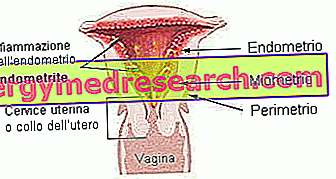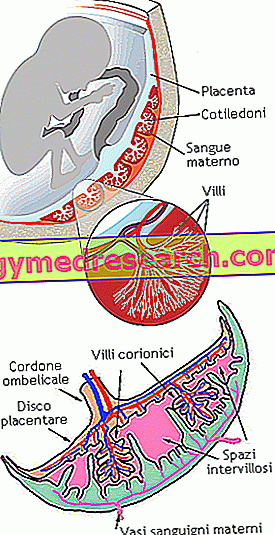Definition of endometritis
Endometritis is an infectious-inflammatory process of the endometrium, the mucosa that covers the uterus internally. When the infection goes even to the level of the myometrium, one speaks correctly of endomyometritis.
Step back to understand ...
- The endometrium is the mucous membrane that covers the uterine cavity internally
- The perimeter is the serous tunic of the uterine cavity, a peritoneal leaflet that constitutes the outermost part of the uterine wall
- The myometrium is instead the muscular layer of the uterine wall, between the perimeter and the endometrium.

Endometritis is one of the most frequent causes of abnormal and unexpected uterine bleeding. Alongside these unique uterine losses, endometritis triggers a series of symptoms, especially pain in the lower abdomen, fever and spotting.
Endometritis must be promptly treated with an antibiotic therapy, specific to remove or kill the responsible pathogen.
Classification
Two forms of endometritis differ:
- Acute endometritis : it mainly affects women in the immediate postpartum period. The acute form of the disease is characterized by the presence of micro-abscesses or agglomerates of neutrophil leukocytes in the endometrial glands. It is estimated that only 1-3% of women who have given birth to a child with natural childbirth develop an endometrial infection, while women forced to perform a caesarean section are more at risk (the incidence rate rises at 19-40%). Immediate antibiotic treatment is generally sufficient to reverse acute infection.
- Chronic endometritis : it occurs most often in women outside the gestational period. Chronic endometritis is characterized by the presence of a variable number of plasma cells in the endometrial stroma (or proper tunic). Also in this case, therapy with antibiotic drugs is optimal to remove the symptoms of endometritis.
Causes and risk factors
CAUSES
In most cases, endometritis is caused by multiple infection; as such, the inflammation is therefore triggered by two or more pathogens.
The etiological agents most involved are bacteria of the type:
- Cocchi gram +: Staphylococcus spp., Streptococcus spp . (in particular group B hemolytic streptococcus)
- Gram - pathogens: Escherichia coli, Klebsiella spp., Proteus spp., Enterobacter spp., Gardnerella vaginalis, Neisseria spp.
- Anaerobic bacteria: Peptostreptococcus spp., Bacteroides spp.
- Others: Mycoplasma spp., Ureaplasma spp., Mycobacterium tuberculosis
RISK FACTORS
We have observed that women who are most at risk of endometritis are women in labor . In addition to this circumstance, women are more sensitive to endometrial infections in the following cases:
- Gestational anemia
- STDs (sexually transmitted), such as chlamydia or gonorrhea
- Acute salpingitis
- Acute cervicitis
- Advanced age of the expectant mother
- Pelvic inflammatory disease or metritis
- Cervical cancer associated with infections
- Cervical stenosis (narrowing of the cervical canal)
- Diagnostic investigations / surgical interventions, such as hysteroscopy or curettage: an imperfect intervention can tear the inner uterine wall, causing endometritis
- Introduction of the IUD contraceptive device. Similar to the previous condition, endometritis, in this case, derives from a lesion of the uterine lining mucosa after the imperfect introduction of the IUD device
- Frequent unprotected sexual relations with subjects at risk
Symptoms
The clinical picture of endometritis is expressed in the following symptoms:
- Abnormal uterine bleeding
- General weakness
- Dyspareunia (pain during intercourse)
- High fever *
- grade fever
- Strong abdominal pain
- Abdominal swelling
- Headache
- Abundant menstruation * (hypermenorrhea or menorrhagia)
- Smelly and purulent uterine losses *
- Constipation (infrequent)
- Tachycardia
The symptoms marked with (*) are characteristic - albeit not exclusive - of acute endometritis.
Normally, pain is not perceived until the infection goes beyond the endometrium, even invading the myometrium. In similar situations, the pain caused by inflammation of the uterus (metritis) is accentuated on palpation, during a cough or sneeze.
Untreated endometritis can trigger serious complications, causing the clinical picture to precipitate. Possible complications include: peritonitis, adnexa, pelvic abscess and pelvic hematoma.
Diagnosis
The combination of physical examination, medical history and pelvic examination is generally sufficient to establish suspicion of endometritis. In case of uncertain diagnosis, it is possible to proceed with further investigative examinations. In this sense, the hypothesis can be denied or confirmed by:
- Venereal disease test (culture test of cervical cells for Chlamydia trachomatis, Neisseria gonorrhoeae, etc.)
- Endometrial biopsy: a tissue sample can be taken, for example, by hysteroscopy or curettage
- ESR (erythrocyte sedimentation rate in plasma)
- Laparoscopy
- CT scan (computer-assisted tomography)
- Blood tests
- Examination of feces and urine
- PAP test
The differential diagnosis must be placed between endometritis and all the diseases that are characterized by similar symptoms. These include: appendicitis, pelvic inflammatory disease, pyelonephritis and urinary tract infection.
Care
Fortunately, it is rather simple and immediate to dominate and eradicate endometrial infection. The treatment consists in administering broad-spectrum antibiotics or - if the responsible pathogen is identified - a specific antibiotic.
The most widely used antibiotics for treating endometritis are:
- Clindamycin and gentamicin, to be administered intravenously up to 24 hours after the disappearance of the fever.
- Amoxicillin + gentamicin + metronidazole: the combination of these three drugs is used for the treatment of uncomplicated endometritis
- Doxycycline: the drug is indicated for the treatment of endometritis associated with chlamydia
In 90% of cases, antibiotic therapy against endometritis guarantees an excellent prognosis. It is noted that most women recover completely from endometritis symptoms 48 to 72 hours after starting treatment.
Continue: Endometritis Medications »



